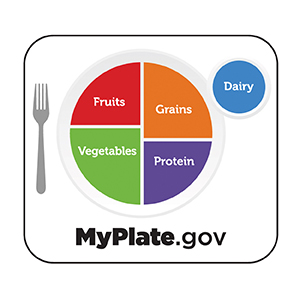Preschooler Nutrition
Helpful feeding information for your preschooler
Preschool-age children (ages 3 to 5) are still developing their eating habits and need encouragement to eat healthy meals and snacks. These children are eager to learn. They will often imitate eating behaviors of adults. They need supervision at mealtime as they are still working on chewing and swallowing skills.
These are some helpful mealtime hints for preschool-age children:
-
Provide regularly scheduled meals and snacks, and limit grazing.
-
Discourage poor behavior at mealtime. Focus on eating, not playing at the dinner table. Turn off the TV and put away cell phones and other electronics during mealtime.
-
Running or playing while eating can cause a child to choke. Have your child sit when eating.
-
Keep offering a variety of foods in a variety of ways. Have the attitude that, sooner or later, your child will learn to eat almost all foods.
-
Make mealtime as pleasant as possible. Don't put pressure on your child to eat. Don't force your child to "clean" their plate. This may lead to overeating, which can cause your child to gain too much weight. Some days, children will eat everything, while other days, they may eat very little. This is normal and usually ends up evening out over time.
-
Don't let your child fill up on drinks like milk and juice during the day. This will lead to them being less hungry during meals and snacks.
-
Provide an example of healthy eating habits. Preschoolers copy what they see their parents doing. If you have unhealthy eating habits, your child will not learn to eat healthy.
Healthy food choices
To help families make healthy food choices, the USDA and the U.S. Department of Health and Human Services created the MyPlate icon. MyPlate can help you and your child eat a variety of foods while encouraging the right amount of calories and fat. Learn more about MyPlate and find healthy recipes and tips at MyPlate.gov.
The MyPlate icon is divided into the 5 food groups:
-
Grains. Foods that are made from wheat, rice, oats, cornmeal, barley, or another cereal grain are grain products. Examples include whole wheat, brown rice, and oatmeal. Aim for mostly whole grains.
-
Vegetables. Vary your vegetables. Choose a variety of colorful vegetables. These can include dark green, red, and orange vegetables, legumes (peas and beans), and starchy vegetables.
-
Fruits. Any fruit or 100% fruit juice counts as part of the fruit group. Fruits may be fresh, canned, frozen, or dried and may be whole, cut up, or pureed. The American Academy of Pediatrics recommends no more than 4 ounces of juice per day for children 1 to 3 years of age, and 4 to 6 ounces per day for children 4 to 6 years of age.
-
Dairy. Milk products and many foods made from milk are considered part of this food group. Focus on fat-free or low-fat products, as well as those that are high in calcium.
-
Protein. Go lean on protein. Choose low-fat or lean meats and poultry. Vary your protein routine. Choose more fish, nuts, seeds, peas, and beans.
Oils are not a food group. But some oils, like those from some nuts, fish, and olives, have essential nutrients and should be part of the diet. Stay away from saturated fats, which are solid fats.
Encourage active play and everyday physical activity along with a healthy dietary plan.
Nutrition and activity tips
Here are some tips to follow:
-
Try to control when and where food is eaten by your children by providing regular daily meal and snack times. Include social interaction and demonstrate healthy eating behaviors.
-
Include children in the choosing and preparing of foods. Teach them to make healthy choices by helping them to pick nutritious foods.
-
Select foods with these nutrients when possible: calcium, magnesium, potassium, and fiber.
-
Preschoolers don't need large servings of food. Offer small servings for meals and snacks. If you need guidance on serving sizes for your child, explore the MyPlate Plan on MyPlate.gov.
-
Parents are encouraged to limit children’s screen time to less than 1 hour daily. Instead, encourage activities that call for more movement and active play.
-
Children and teens need at least 60 minutes of moderate to vigorous physical activity on most days for good health and fitness and for healthy weight during growth. Try to make activity fun and engaging rather than a chore.
-
To prevent dehydration, encourage children to drink fluids regularly during physical activity and drink several glasses of water or other fluid after the physical activity is completed.
To find more information about the Dietary Guidelines for Americans 2020–2025 and to determine the appropriate dietary recommendations for your child’s age, sex, and physical activity level, visit the MyPlate.gov and 2020–2025 Dietary Guidelines sites. Please note that the MyPlate Plan is designed for people older than age 1 who don't have chronic health conditions.

Always talk with your child’s healthcare provider regarding their individualized diet and exercise requirements.
Online Medical Reviewer:
Chris Southard RN
Online Medical Reviewer:
Marianne Fraser MSN RN
Online Medical Reviewer:
Rajadurai Samnishanth
Date Last Reviewed:
2/1/2024
© 2000-2025 The StayWell Company, LLC. All rights reserved. This information is not intended as a substitute for professional medical care. Always follow your healthcare professional's instructions.